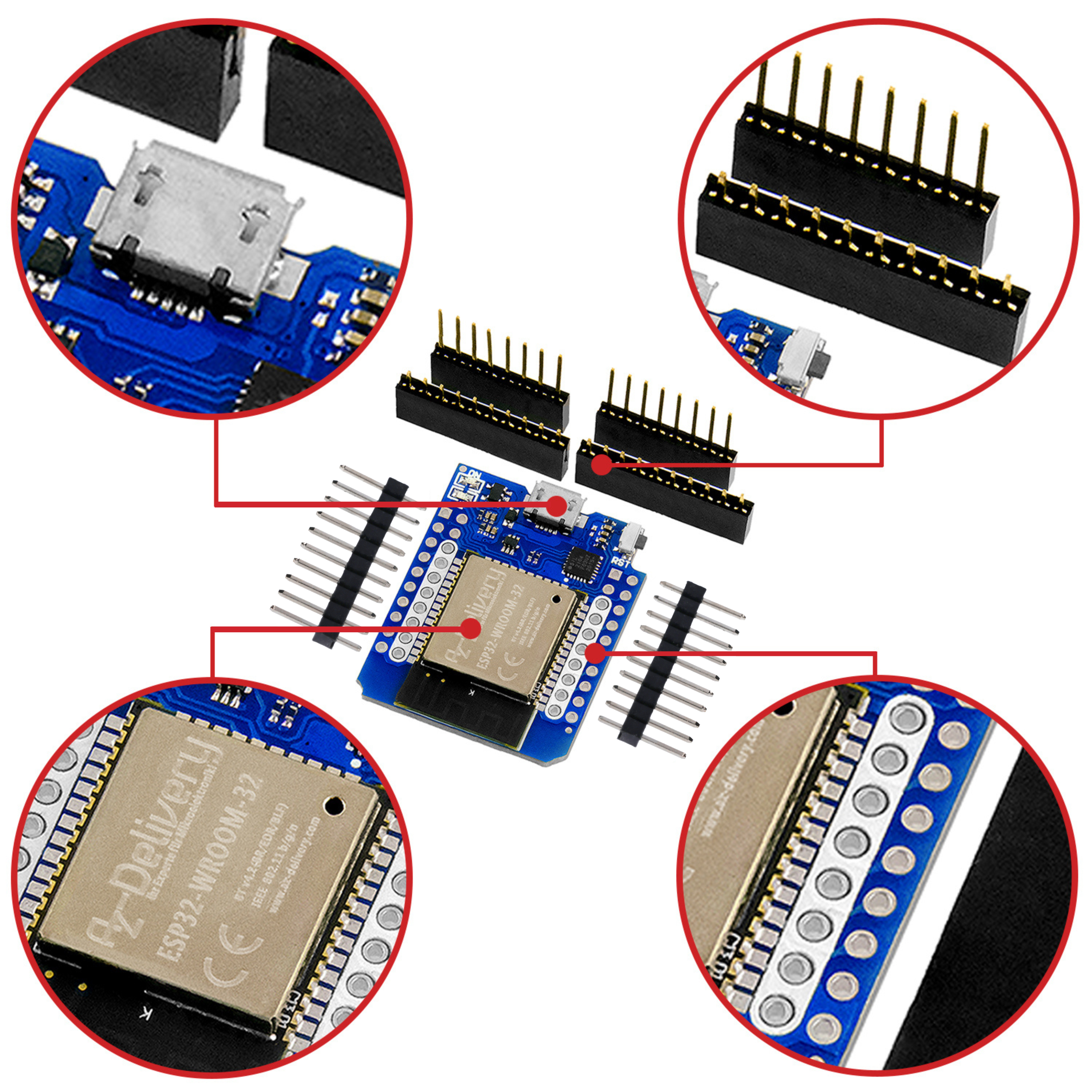In this video, we would like to introduce you to the microcontroller ESP8266-01S and Digispark Attiny85. The technical specifications and differences between both controllers are explained as part of the video. In addition, we show several sample circuits to show how the microcontrollers can be used and how the cabling works.
! Attention: If the video is not displayed for you, you should check your cookie settings. You have to accept cookies so that the video is visible! Alternatively, you can also find it on our YouTube Channel.
Here you will find the microcontrollers presented:
Wiring ESP8266-01S:

Code ESP8266-01S:
/* ___ _____ ____ ___ / /__ / / __ \___ / (_) _____ _______ __ / /| | / / ______/ / / / _ \/ / / | / / _ \/ ___/ / / / / ___ |/ /_/_____/ /_/ / __/ / /| |/ / __/ / / /_/ / /_/ |_/____/ /_____/\___/_/_/ |___/\___/_/ \__, / /____/ Product, data sheet and Pinout at: https://www.az-delivery.de/ Project: ESP8266-01S Date: 03/2022 Link ESP8266WebServer.h: https://github.com/esp8266/ESPWebServer */ #include "ESP8266WIFI.H" #include "ESP8266WebServer.h" #include "credentials.h" intimately ledpine=2; // content of the website String a= " "; String out of= " switch off "; String output=" " "
LED control
"+a+out of+""; ESP8266webserver server(80); // Optionally define a fixed IP address Ipaddress IP(192,168,178,83); Ipaddress gateway(192,168,178,1); Ipaddress subnet(255,255,255,0); void Home page() { server.send(200, "Text/HTML", output); } void tooggled(){ digital(ledpine, !digital read(ledpine)); // The start page should be displayed after calling the left server.send(200, "Text/HTML", output); } void set up() { Serial.Begin(115200); pin mode(ledpine, OUTPUT); digital(ledpine, Low); Wifi.Begin(SSID, passport); Wifi.config(IP, gateway, subnet); while(Wifi.status() != Wl_connected){ delay(500); Serial.print("."); } server.on("/",Home page); server.on("/a", tooggled); server.on("/out of", tooggled); server.Begin(); } void loop() { server.handle client(); }
Associated credentials:
Const Char* ssid = "Meinessid"; Const Char* Pass = "42iStmeinpasswort";
Wiring Digisparkt Attiny85:

Code Digispark Attiny85 (temperature):
/* ___ _____ ____ ___ / /__ / / __ \___ / (_) _____ _______ __ / /| | / / ______/ / / / _ \/ / / | / / _ \/ ___/ / / / / ___ |/ /_/_____/ /_/ / __/ / /| |/ / __/ / / /_/ / /_/ |_/____/ /_____/\___/_/_/ |___/\___/_/ \__, / /____/ Product, data sheet and Pinout at: https://www.az-delivery.de/ Project: Attiny85 - Digispark Rev.3 Date: 03/2022 Driver: https://github.com/digistump/DigistumpArduino/releases/download/1.6.7/Digistump.Drivers.zip Board administrator URL: http://digistump.com/package_digistump_index.json Digisparkoled.H: https://github.com/digistump/DigistumpArduino/blob/master/digistump-avr/libraries/DigisparkOLED/DigisparkOLED.h Tinydht: https://github.com/adafruit/TinyDHT */ // display #include <Tinydht.H> #define Dhtype DHT11 #define Tempype 0 // use fahrenheit (0 for Celsius) #define Dhtpin 1 // sensor connected to gpio #1 Dht dht(Dhtpin, Dhtype); // Define temp sensor #include <Digisparkoled.H> void set up() { Serial.Begin(115200); OLED.Begin(); delay(100); dht.Begin(); // Initialize DHT Tepperature Sensor } void loop() { IF(Millis()%500==0){ int8_t H = dht.readhumidity(); // Read humidity int16_t T = dht.Reading temperature(Tempype); // Read temperatures OLED.clear(); OLED.setcursor(12, 0); OLED.set font(Font8x16); OLED.print(F("AZ-Delivery")); OLED.setcursor(25, 6); OLED.print(T); OLED.setcursor(70, 6); OLED.print(H); } }
Code Digispark Attiny85 (keyboard):
#include "Digikeyboard.H" void set up() { // Don't need to set anyding up to use Digikeyboard Digikeyboard.update(); } void loop() { Digikeyboard.update(); delay(100); Digikeyboard.Sendkeystroke(0); Digikeyboard.Sendkeystroke(Key_r, Mod_gui_left); // meta+r delay(100); Digikeyboard.print("Notepad"); delay(200); // y + z Switched :) Digikeyboard.print("Hello from Ay Deliverz!"); // It's Better to use Digikeyboard.Delay () Over the Regular Arduino Delay () // if doing keyboard stuff Because it keeps talking to the computer to make // Sure the Computer Knows the keyboard is alive and connected Digikeyboard.delay(5000); }











4 Reacties
Andreas S
Mit dem ESP hab ich schon ein wenig gebastelt, ein nettes, kleines Teil mit dem man viel mehr machen kann. Besonders mit dem I2C-Bus gibt es viele Möglichkeiten.
Im Video wird der Baustein programmiert, während der D0 auf GND gesetzt ist. Korrekterweise müsste doch der Pin beim Power-Up bzw Reset auf GND sein, damit das Modul in den Programmiermodus hineinbootet. (Tipp: RST-Pin auch über Taster an GND!)
Sollte man nicht einen Vorwiderstand in Reihe mit der LED schalten ?
Andreas Wolter
@Thomas Tasler: wenn kein Video angezeigt wird, könnte das an den Cookieeinstellungen liegen. Unter dem Video finden Sie einen Hinweis dazu. Außerdem einen Link direkt zu Youtube, um sich das Video dort anzuschauen.
Grüße,
Andreas Wolter
AZ-Delivery Blog
Ralf M.
Den ESP01 kannte ich so noch gar nicht, gerade wegen der kleinen Größe gefällt mir der ausgesprochen gut.
Danke fürs Zeigen und bitte gern mehr von den Videos, sehr gut erklärt!
Beste Grüße aus Hannover
Ralf
Thomas Tasler
Von welchem Video ist hier die Rede – ich sehe nur ein Bild mit Ankündigung, aber ein Video gibt es nicht !